
Passover haggada with the Yefe Nof commentary by Rabbi Chaim Gavriel Bloch, with elucidations on the words of his father, Rabbi Yosef Bloch. Lemberg, H. Grossman press, 1808.
Specifications: 22 leaves, 21 cm. Stefansky, Chassidut 159. Yaari 362. Otzar Haggadot 517.
Background: Early chassidic haggada. The author, Rabbi Chaim Gavriel Bloch, was the son of Rabbi Yosef Bloch. Rabbi Yosef was a member of the “chabura” of the Maggid of Mezeritsch and author of the noted chassidic work Ginzei Yosef, which received enthusiastic approbations from chassidic greats. The work was published by his son, Rabbi Chaim Gavriel. Rabbi Chaim Gavriel [c. 1754-1824] was the rabbi of Kunëv [near Rivne – currently in the Ukraine]. In this Haggada, he quotes his father’s work and explains and expands on his words. The Admors of the Nadvorna dynasty are his progeny.
Unique features: Rare haggada. Owner stamp on the title page: HaRav Menachem Mendel Kahana of Humenné, Slovakia. Rabbi Menachem Mendel Kahana was the Admor of Spinka-Kahana. He was the grandson of the “Imrei Yosef” and the son of Rabbi Nachman of Spinka. He married the daughter of Admor Avraham Krestir, the son of Rabbi Yeshaya Steiner, noted Admor of Krestir. He served as Admor of Humenné and was killed in the Holocaust. Two of his sons served as Admors in Eretz Yisrael.
Condition: Fine. Aging stains. New leather binding.
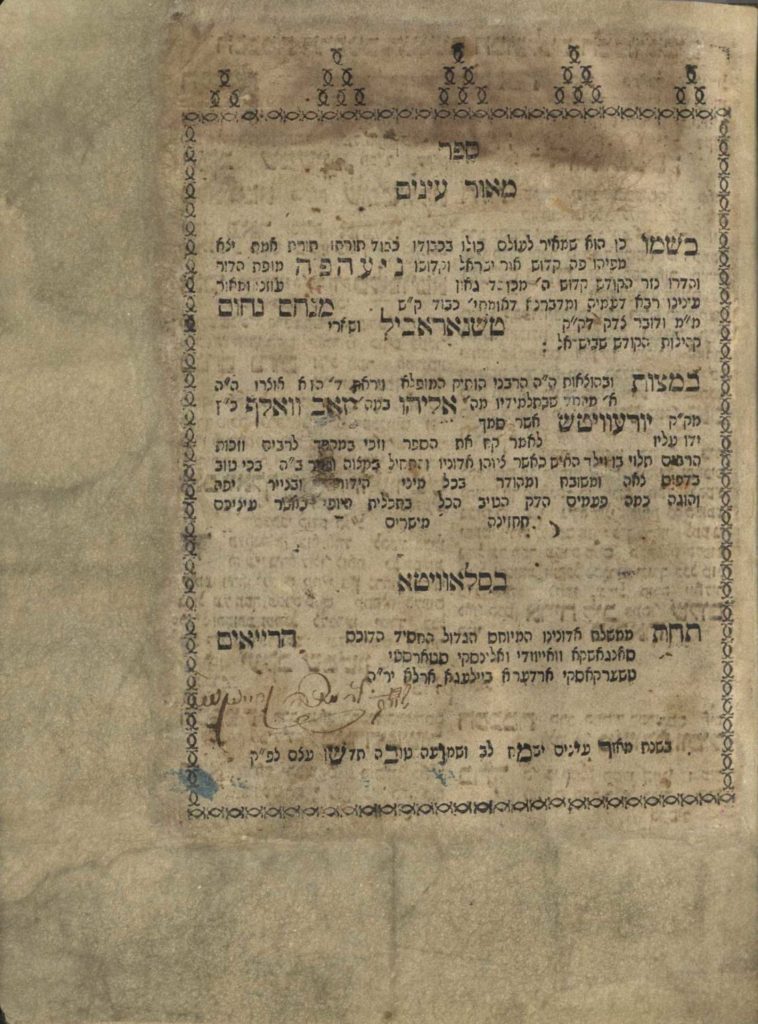
Meor Einayim . Chassidut on the order of the weekly Torah readings, by Admor Menachem Nachum Twersky of Chernobyl. Slavuta [at the press of Rabbi Moshe Shapiro]. [1798]. First edition. Unknown title page. Nice, wide-margined copy.
Unique features:
1. Unknown variant title page: This is apparently the first version – the only extant copy – of the title page printed with an error in regards to the author’s city: טשנאראביל instead of טשארנאביל. In addition, the title page border is different than those in other bibliographically known copies and the order of the words in the lines of the title page and leaves of approbations are also different than the known copies. This error was apparently discovered before printing and then corrected, since there are no other known copies with this title page.
2. Wide margins. Some of the margins have not been cropped at all and remain in their original format.
3. Segula. Some Admors instructed their chassidim to keep a copy of this work in their tallit and tefillin bags as a segula for protection and success.
Specifications: [2], 160 leaves. Wide margins. 21 cm. Blue paper. Stefansky, Chassidut 308.
Background : A classic chassidic work, authored by the first Admor of the Chernobyl dynasty. He quotes many ideas that he heard from the Baal Shem Tov. Rabbi Menachem Nachum Twersky [1730-1787] was a disciple of the Baal Shem Tov and then the Maggid of Mezeritsch. He founded a chassidic dynasty with many branches. This work was printed right around the time that he passed away, and in a number of places he is mentioned with the honorific indicating that he was still alive. The book was printed by his disciple, Rabbi Eliyahu. The author authorized him to print the book “in the nice, elegant press established in Slavuta.” The book was printed with the goal of disseminating the Torah of chassidut. It includes approbations from chassidic leaders, Rabbi Yaakov Shimshon of Shepetovka, Rabbi Levi Yitzchak of Berditchov, Rabbi Meshulem Zussa of Anipoli, and more. Includes an introduction describing the author’s greatness. Chassidic tradition includes lofty words regarding this work. It is related that the work was much larger, but the Admor left instructions before his death that only a small portion should be published – only the words “that the holy Shechina spoke through [his] mouth.” Some Admors make sure to learn a section of this work every single day. Tens of editions of this work have been printed, and it is studied in depth by the leaders of chassidut.
Bound with:
Yismach Lev . Elucidations on the aggadot and medrashim of Chazal by Rabbi Menachem Nachum Twersky of Chernobyl. Slavuta [at the press of Rabbi Moshe Shapiro]. [1798]. First edition. Variant.
Unique features:
1. Unique variant: This book was printed right around the time that the Admor passed away, so most known copies bear the word “Zatza”l.” Both title pages in this copy, Meor Einayim and Yismach Lev , mention the author with the honorific indicating that he was still alive. It is almost certain that this copy was printed during the author’s life (!).
The back of the title page, in the Ka vanat HaMikvah B’Ketzara , features changes to the order of words within the lines.
2. Wide margins: Some of the margins were not cropped and remain in their original format.
Specifications: [1] 34 leaves, 21 cm. Wide margins. Blue paper. Stefansky, Chassidut 237.
Background: The book was printed together with Meor Einayim and the last pages feature Likutim L’Sefer Meor Einayim, with the Kavanat HaMikvah B’Ketzara.
The titles of both works were taken from the verse in Proverbs: “Meor Einyaim Yismach Lev” and contain other allusions. These are two of the earliest chassidic works ever printed.
Condition: Fine-very fine. Supplemental paper has been professionally mounted in the blank margins of the title page and first leaf ( Meor Einayim ) (not affecting text). Aging stains. Solitary, restored worming holes. The margins of a number of leaves have been lightly restored. Magnificent leather binding.
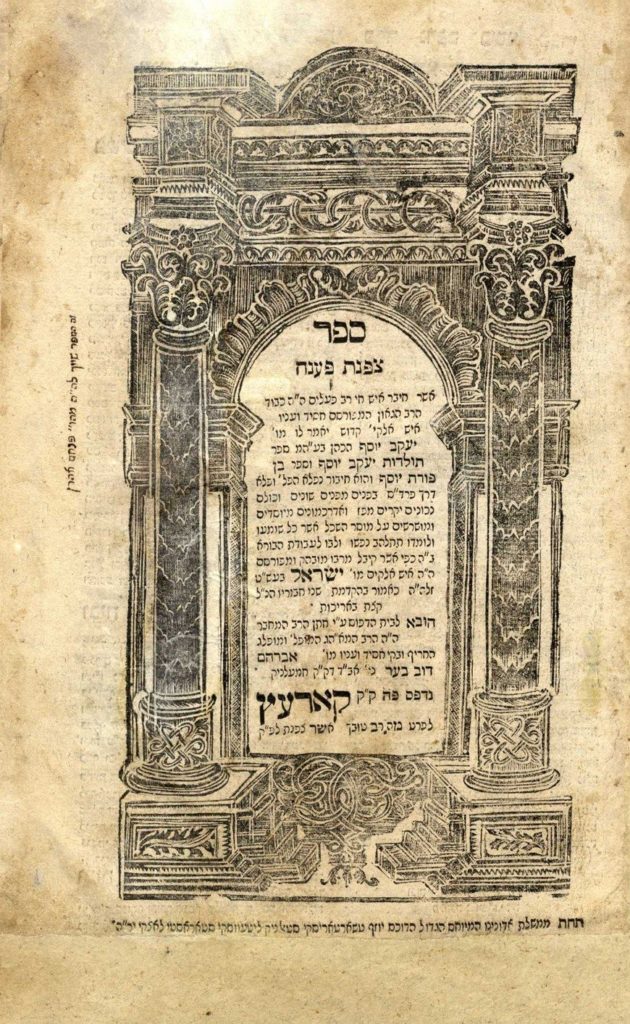
Tzafnat Paneach. Amazing work by the G-dly, sacred man..Rabbi Yaakov Yosef [of Polnoye]… as he received from his famed rebbe..Yisrael Besh”t zlh”h. Korzec. [1782]. First edition.
Specifications: [1] 95 leaves, 30 cm. Stefansky, Chassidut 505. Thick white paper.
Background: Rabbi Yaakov Yosef HaKohen of Polonye was a leading disciple of the Baal Shem Tov. He quotes ideas that he heard from the Besh”t, as he indicates, “I heard from my teacher” or “I received from my teacher.”
This is one of the most significant chassidic works. It was one of the first chassidic works ever printed. It was published during the author’s lifetime, by Rabbi Avraham Dov Ber Auerbach, Rabbi of Khmelnik, the author’s son-in-law, who succeeded him as rabbi of Polonye.
Unique features: It was through this work that the Chid”a was familiarized with the chassidic movement. He writes in his Shem HaGedolim (entry: Tzafnat Paneach ): “Nice sermons in the way of Parde”s in a few manners, authored by Rabbi chassid Yaakov Yosef, and he often stated introductions from his famed teacher…Yisrael Baal Shem Tov. And we already knew that this Rabbi printed Toldot Yaakov Yosef and we give him the praise and there it says that he authored the Ben Porat Yosef . Tzafnat Paneach was printed in Korzec in 1782.
This work was printed about a year after the excommunication on chassidut. The printing of the author’s Toldot Yaakov Yosef in 1780 was one of the triggers for the rekindling of the battle against chassidut. This caused all of the author’s works to be persecuted and banned and they are, therefore, rare.
Condition: Fine-very fine. The margins on the bottom of the title page have been professionally supplemented. The blank margins of leaf 52 have been cropped along the length of the leaf. Aging stains. Magnificent leather binding.
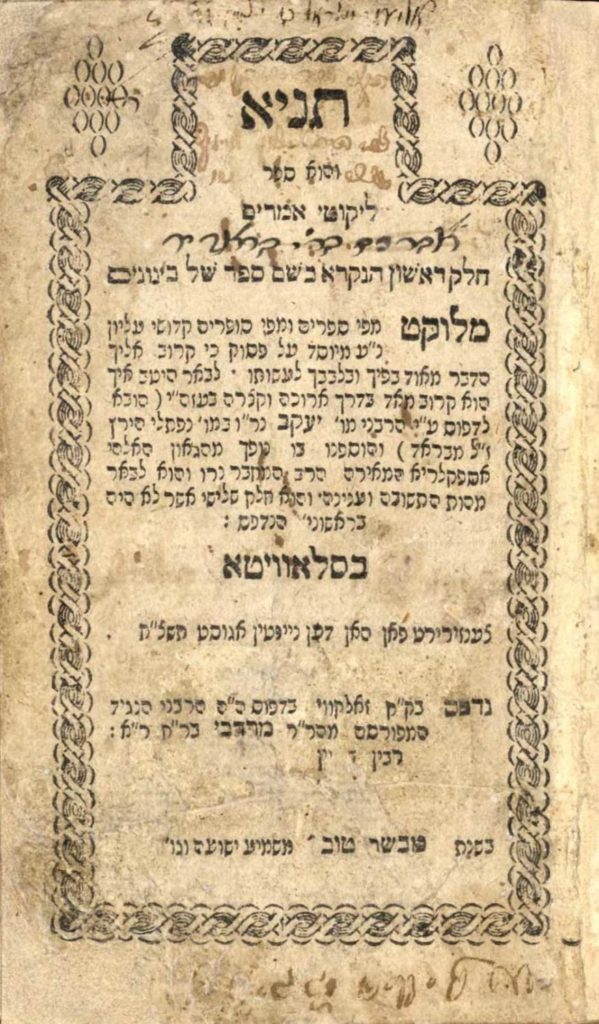
The Book of the Tanya, which is the book Likutei Amarim, by [Rabbi Shneur Zalman of Liadi]. Zolkiew, in the printing press of Mordechai Rabin Stein. 1798. Second edition of the book of the Tanya and the first edition of the third section of the book of the Tanya. A copy with variations on the known copies.
.Specifications: [3] 2-74 leaves, 17 cm. Y. Mondshine, Sefer HaTanya Mahadurotav Tirgumav U’Biyurav 2. Sha’arei Chabad 48
Background: The edition before us is the first to include the third section. The book was printed in the author’s lifetime. As is written on the title page: And we added depth to it from the G-dly sage, the author, which is to examine the essence of repentance. This is the third section which was not in the first ones printed in Slavita…with special approbations given to this edition. The words of the activist Yaakov son of Naftali Hirtz of Brody are at the end of the book.
The first edition in which the book was called Sefer HaTanya , is how it has been referred to ever since. The early edition before us was printed without the author’s name, and even the writers of the approbations do not hint to the author’s identity, despite apparently knowing who he was. As appears in one of the approbations ‘and due to his great humility, the author’s name is unknown’. For more on this and on the name ‘Tanya’ refer at length to Y. Mondshine’s book Sefer HaTanya Mahadurotav Tirgumav U’Biyurav pages 36-43.
Unique Features: The order of the lines at the end of part three [page 73a] is different than in the known copies and than what is listed in Y. Mondshine’s book, refer to the facsimile there on page 39.
On page 67a at the end of part two is written: The activist says ha maon (!) the author had a precious gem, a booklet in manuscript form… and it should say “MeHaGaon”. Refer also to Mondshine’s book (page 39 and footnote 11) that there are copies in which the word “Hamagaon” appears. He refers to a copy owned by Haberman (Sha’arei Chabad 48) which he writes ‘Hamaon’ which surprises him. However, in the copy before us the word ‘Hamaon’ indeed appears.
Condition: Fine-very fine. The book underwent professional restoration, primarily on the corners of the leaves. Stains. Magnificent leather binding.

Zera Kodesh on the Torah and festivals, by Rabbi Naftali Horowitz of Ropshitz. Lemberg, 1868. Two parts. First Edition.
Specifications: Part one: on the five books of the Torah. [2], 100 [24] leaves. Part two: Homiletics on the months and the festivals and on the Pesach Haggadah. [1], 120 leaves.
22 cm. Stefansky Chassidut 208.
Unique Features: First edition of the well known book of one of the great Chassidic teachers of all time.
Content: An especially interesting introduction from Rabbi Chaim Halberstam of Sanz, who learned Chassidut from the author. He writes that he once thought that the book should not be printed at all, as he knew that the holy author was not prepared for his teachings to be printed in his lifetime, . However, he later thought that just as the great Rabbis of the time used many cunning methods to print Rabbi Chaim Vital’s writings, despite his refusal to print any of them, even those he received from the Ari, so too, the writings of the author before us should also be printed. The publishers note that the Rebbe of Sanz gave the book the name Zera Kodesh . With an approbation from Rabbi Yosef Shaul Nathansohn, who refers to the author as, ‘The holy Rabbi, the wonder of the generation.’
Background: Rabbi Naftali Zvi Horowitz was born on Shavuot 1760, the day the Ba’al Shem Tov died. He learned from his grandfather Rabbi Yitzchak of Hamburg, and from Rabbi Meshulam Igra of Tismenitz. He was drawn to Chassidut from a young age and became the primary student of Rabbi Elimelech of Lizhensk. He studied from the Chozeh of Lublin, the Maggid of Koznitz and Rabbi Menachem Mendel of Riminov, and travelled to many Rebbes. At the recommendation of Rabbi Mendel of Riminov, he was appointed as Rabbi of Ropshitz, a position which he held for many years, and by which name he was known from then on. He later served as Rabbi of Linsk (where his father had served as Rabbi), Strzyżów and Sanok. F ollowing the death of his Rabbis, h e began to serve as a Rebbe i n 1815 . He was one of the great Galician Rebbes and considered to be among the greatest disciples of the Chozeh of Lublin. He was famous for his shrewdness and for his witty comments. He died in Lancut in 1827 where he was buried, his descendants served as Rebbes of Ropshitz.
Several books were written about him, Sefer Ohel Naftali which was first published in 1911, and later in many other editions, and more recently the book Rabbi Naftali Zvi M’Ropshitz by Shlomo Tal and the book Toldot Beit Ropshitz-Dzikov by Yitzchak Alfasi.
Condition: Fine. Aging stains. New leather binding.
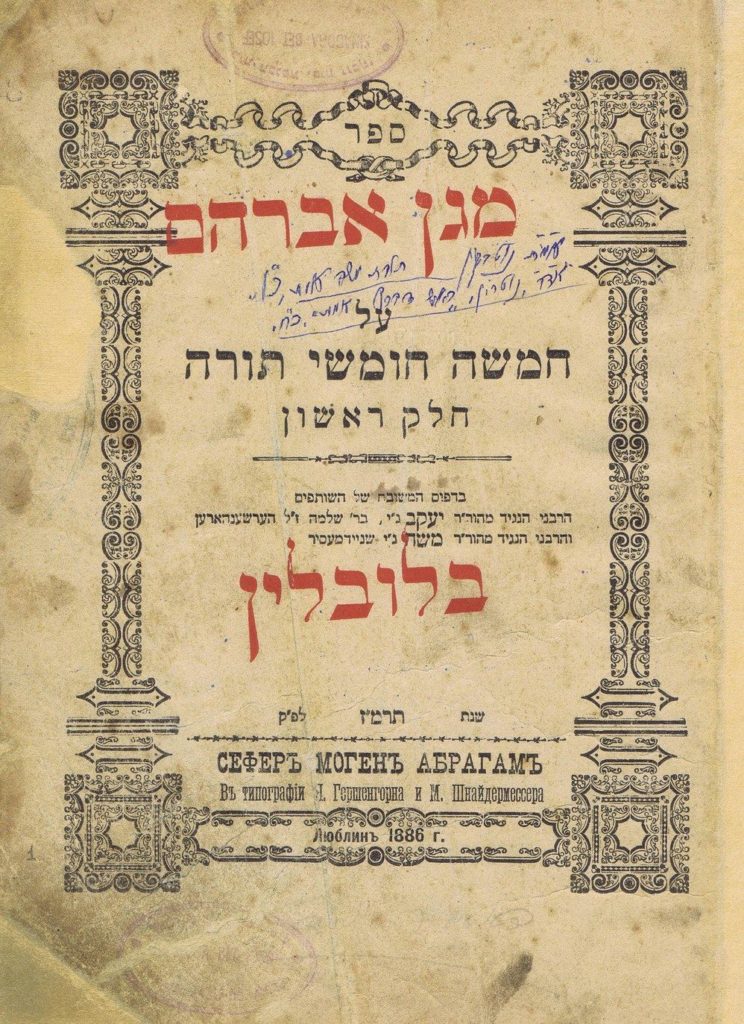
Magen Avraham . Chassidut on the Torah and holidays by Admor Avraham of Trisk. Lublin, 1886. First edition, printed during the author’s lifetime.
Specifications: [3], 3-47, 1-36 leaves; [1], 2-114 leaves. 22.5 cm. Two sections. This copy features 114 leaves, the omission at the conclusion was printed on a separate leaf.
Unique features: Two title pages at the beginning and another in the middle. This is the first edition of the Maggid of Trisk’s work. Leaf [3] features a lithograph of the Admor’s script and signature. This book is considered a “segula,” as per what the author wrote in his introduction. The author wrote that he merited to turn 80-years old, and employing the power of giving blessings that Hashem gave to Avraham who was elderly, “I hereby bless everybody who takes this work, since many chassidim will be drawn to it, that the G-d of Avraham will assist you fulfill all of your requests, children and grandchildren…”
Background: The first Admor of Trisk was the son of Admor Mordechai of Chernobyl. This is a classic work of the Trisk chassidut in particular and of Chernobyl chassidut as a whole.
Condition: Fine. The title page and first two leaves have been professionally restored, without loss of text. Simple binding.
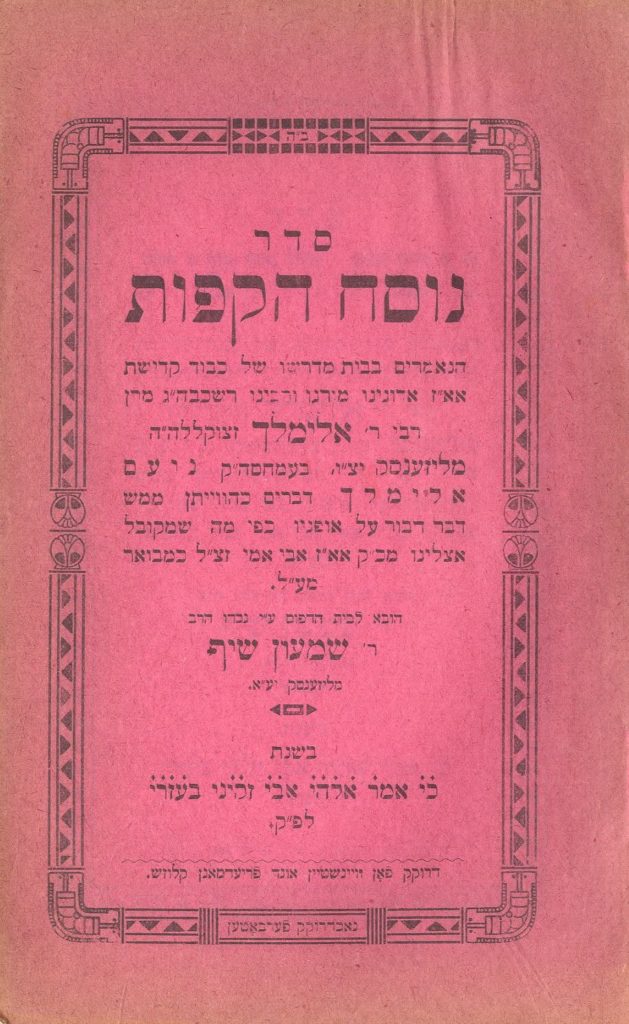
The text of Seder Hakafot that is said in the Beit Midrash of my grandfather our teacher and rabbi … Rabbi Elimelech of Lizhensk. Published by his grandson Rabbi Shimon Schif.
30 leaves. Red title cover. Very fine condition.
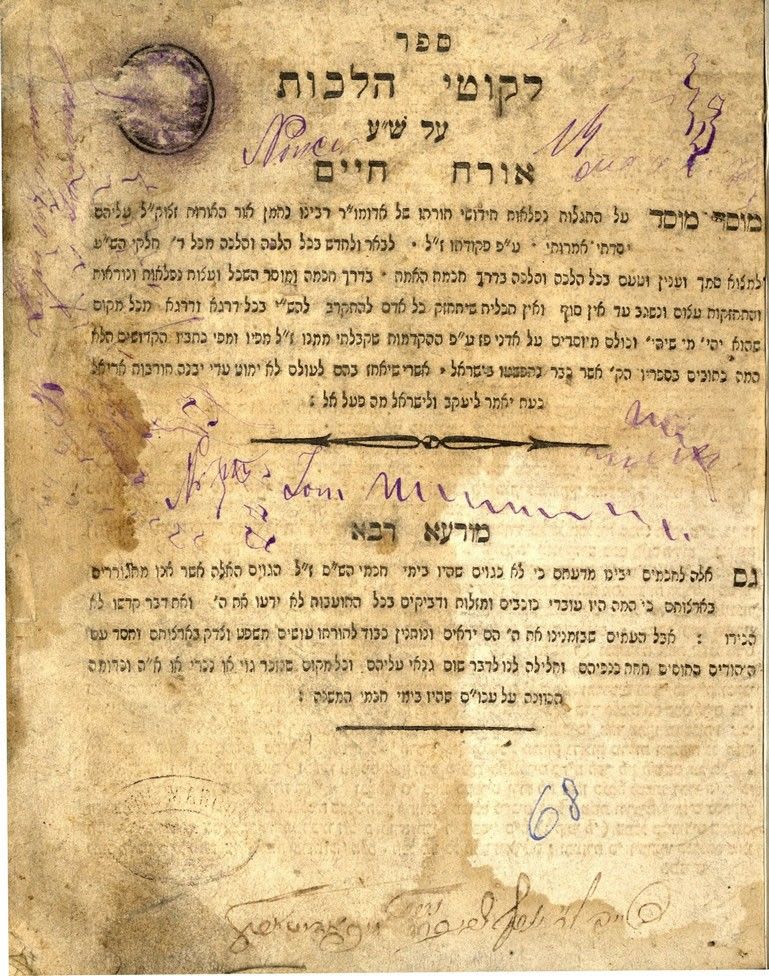
Likutei Halachot on the Shulchan Aruch Orach Chaim [Part one] by Rabbi Natan Sternhartz, the student of Rabbi Nachman of Breslov, who wrote on his teacher’s command. [Lasi, 1843]. First edition.
[2], 117, [1] pages, 21cm. Ownership signature.
Includes the laws of getting up in the morning up to the laws of prayer
[simanim 1-127]. First edition of the book
Likutei Halachot after which the other sections were printed. In many bibliographies they were mistaken about the place and the year of the book before us, and the bibliographies are still divided about when and where the book before us was printed, refer to: Yitzhchak Yudlov, first edition of
Likutei Halachot Orach Chaim ,
Kiryat Sefer , 62, pages 933-935.
Complete copy, on the last pages are the indexes which were edited by Rabbi Nachman Yisrael Halevi Chazan of Tulchyn.
New semi-leather cover. Slight tears in the white margins of the last pages which were professionally restored. Very fine condition. An extremely rare book.
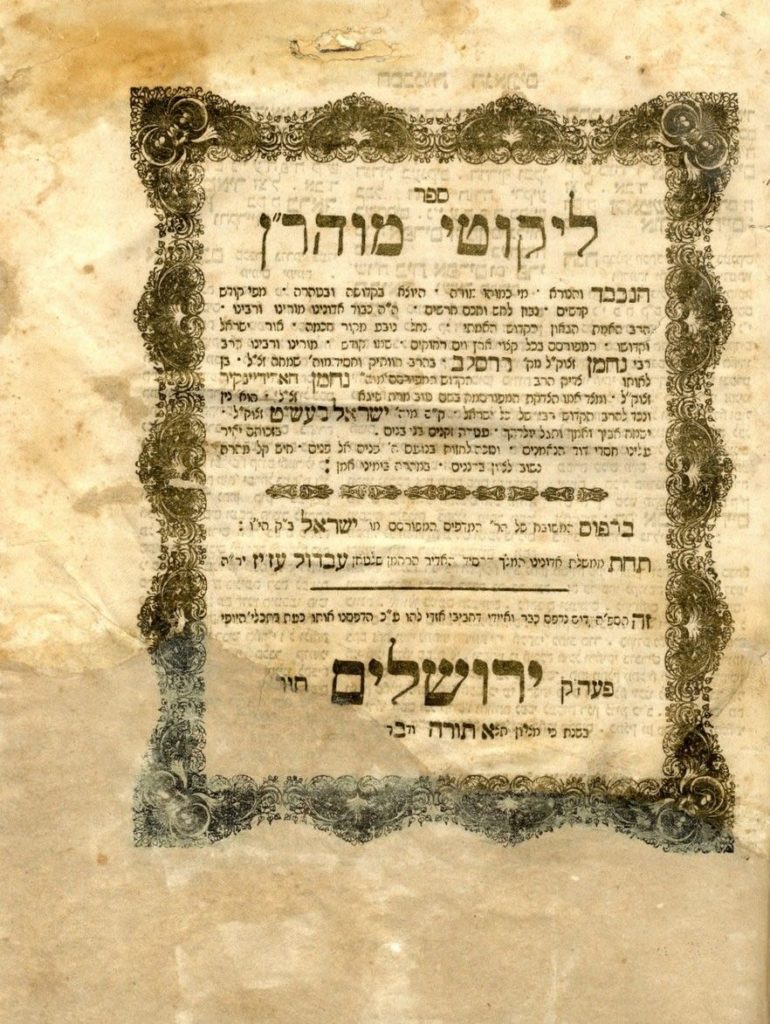
[4], 122, [1]: [1], 44, [3] leaves. Title page in gold letters. Early edition of the
Likutei Moharan of Rabbi Nachman of Breslov. With the addition of “an amazing tale that our rabbi related.” Two sections with two title pages. At the end of the second section there is a picture of the Tiferet Yisrael synagogue. This synagogue was built over many years through the efforts of the printers Rabbi Yisrael Beck and his son, and was inagurated right before the book was printed. Illustration of the Cave of Machpelah on the second title page. Missing leaves 42-44 at the end of the second section, includes the errata and the tale on the last leaf.Sh. Halevi,
Sifrei Yerushalayim HaRishonim 212-213.
New binding. Professionally restored title page. Reinforcements to the second leaf. Fine condition.
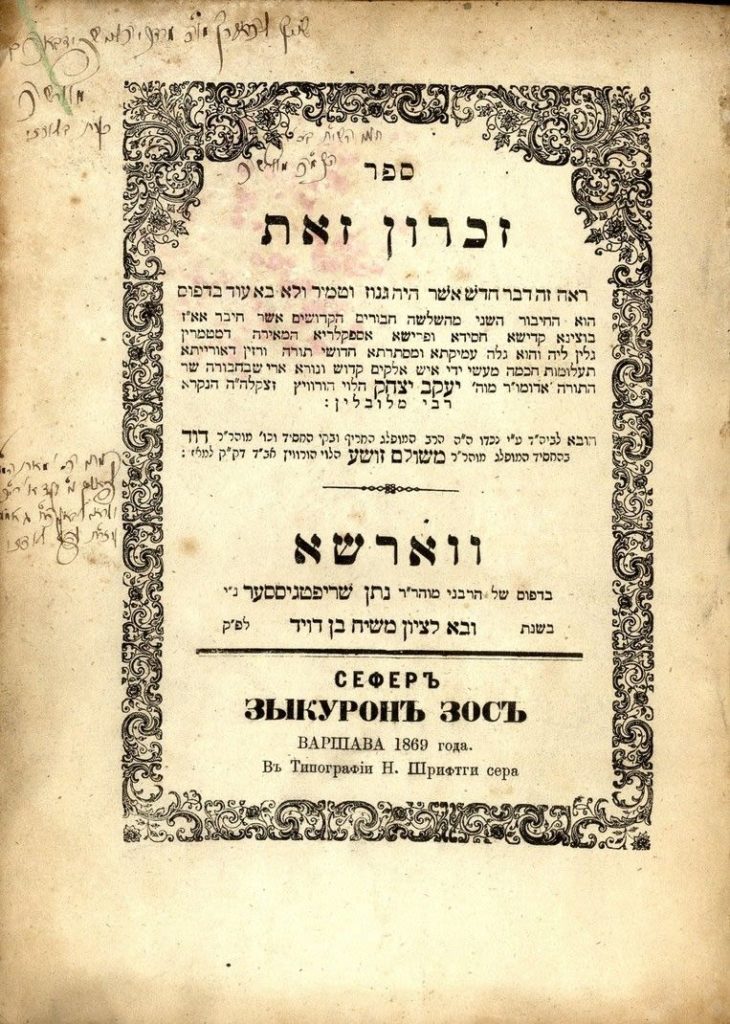
[2] 74 leaves. 23 cm. Particularly thick paper. Owner signatures. First edition of chassidic thoughts by the Chozeh of Lublin, leader of Polish chassidut. Approbation from Rabbi Yosef Shaul Nathansohn and others.
Blemished leather binding. Minimal aging stains. Very fine condition.
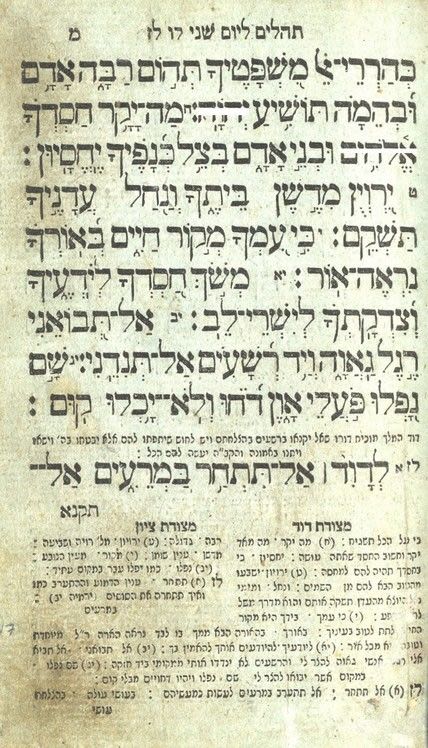
Book of Tehillim with Metzudat David and Metzudat Zion, with a prayer for the evening of Hoshanah Rabbah. [Slavita, the printing press of Rabbi Shmuel Avraham Shapira, 1824?].
24-182 pages, (missing the beginning page [130] and page 144, 16 cm. Blue paper.
A Book of
Tehillim printed on the printing press of Slavita, which belonged to the righteous rabbis of the Shapira family. In the printing press of Slavita only holy books were printed, and the family had special behaviors and customs to ensure the holiness of the books they printed.
The Book of
Tehillim before us was printed in Slavita; however the title page and the beginning are missing, and it is impossible to be certain what year it was printed. It was probably printed in 1824 by Rabbi Shmuel Avraham Shapira, the son of Rabbi Moshe Shapira. This copy begins on page 24 (beginning of Chapter 22 of
Tehillim) until the end of
Tehillim , including the pages of the prayer for after saying
Tehillim and the prayer for the eve of Hoshanah Rabbah. It is possible that the
Tehillim was printed with
Seder Ma’amadot with a separate title page, refer to
Ginzei Yisrael 291.
New simple binding. Use stains and aging stains. A few restored moth holes. Moderate condition.
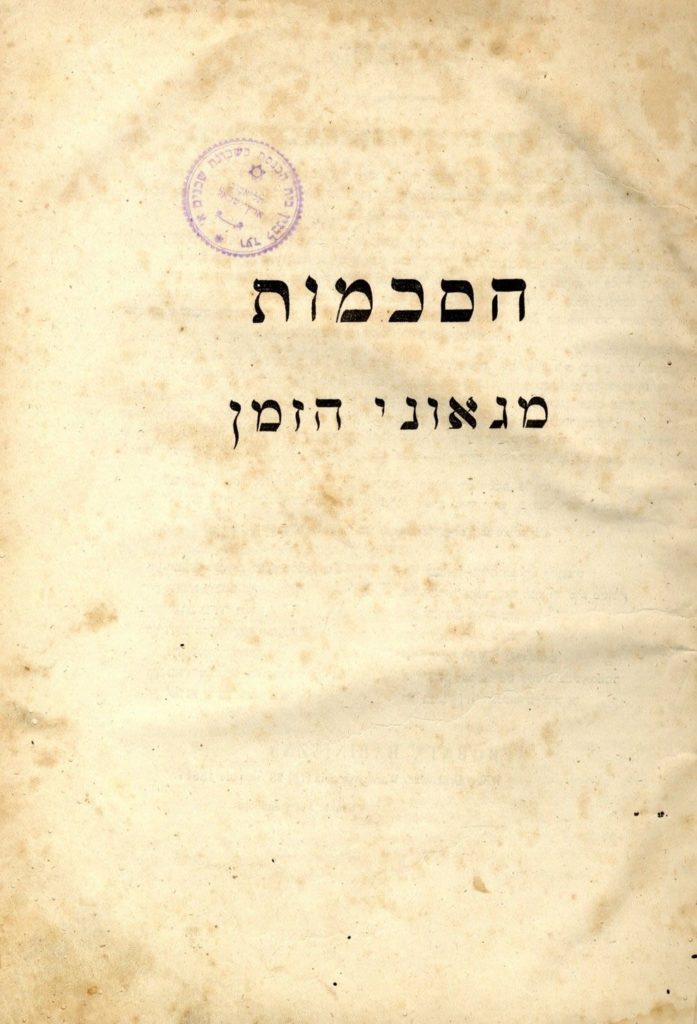
[4] pages, 31 cm.
Unique booklet printed in honor of the start of the printing of the Talmud, printed at the request of the rabbi of Warsaw, Rabbi David Berush Meisels. Includes a number of approbations with many signatories, including some that signed two approbations.
Very lengthy approbation from the rabbis of Warsaw followed by a letter of support from Rabbi Dov Berush Meisels and Rabbi Yitzchak Meir Alter of Gur. Special approbation from Rabbi Yaakov David of Amshinov, son of Rabbi Yiztchak of Vorki.
Bound with Tractate
Ketubot of the Babylonian Talmud with all commentaries. Warsaw, 1861.
Simple binding. Minimal aging stains and worming holes. Fine to very fine condition.
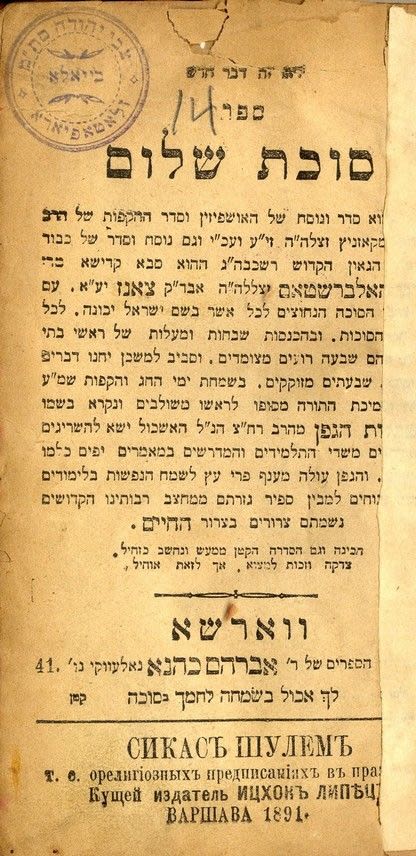
*Sukkat Shalom. Seder and Text of the Ushpizin and Hakafot of Rabbi Chaim Halberstam of Sanz. On the title page: Warsaw, 1891. Censor approval from 1898. Bound with: Netiv L’Chayei Olam. Warsaw, 1899.
*Ushpizin with laws and customs for the seven days of Sukkot along with the text for Simchat Beit HaShoeiva and Hakafot, with rhymes, recited in the beit medrash of the Maggid of Kosnitz [Warsaw?] [8] leaves.
* Seder HaKafot L’Shemini Atzeret and Simchat Torah, recited in the beit medrash of the Admor of Sighet. [Jerusalem], [1961].
*Seder Nusach HaKarbonot, Viduy, Hoshanot and Hakafot as per the custom of Rabbi Zvi Elimelech of Dinov. Bratislava [Pressburg], [1922]. * Perhaps a reproduction *Along with handwritten customs.
* Tefila L’Moshe regarding sukkot and hakafot, according to Admor Moshe Elyakim Beriah of Kosnitz. Published by the surviving Kosnitz chassidim, under the leadership of Rabbi Elimelech Shapiro shlit”a. Tel Aviv [c. 1970].
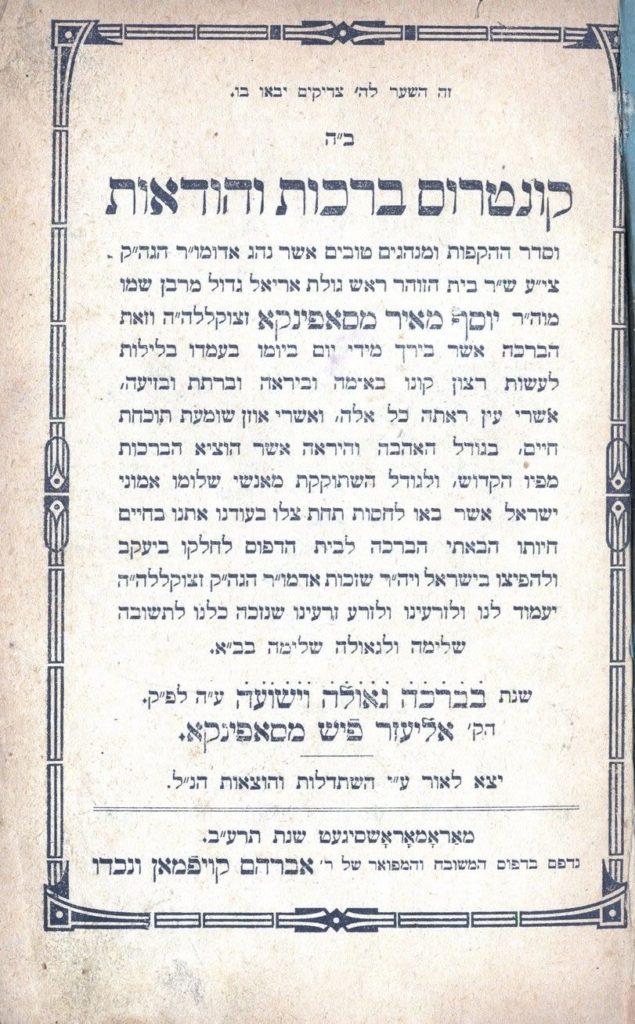
Three small books from Admor Yosef Meir Weiss of Spinka, author of Imrei Yosef . Rare.
* Kuntres Berachot V’Hodaot and the Seder Hakafot and customs of the Admor Yosef Meir of Spinka. Máramarossziget, 1812. 8 leaves.
* Seder Hakafot L’Shemini Atzeret V’Simchat Torah according to the customs of Rabbi Yosef Meir of Spinka. Máramarossziget. 1812. 10 leaves.
Bound together with a section of the Imrei Yosef’s
Hakdamat Likutei Torah V’HaShas . Munkacs, 1811.
Simple binding. Minimal aging stains. Very fine condition.
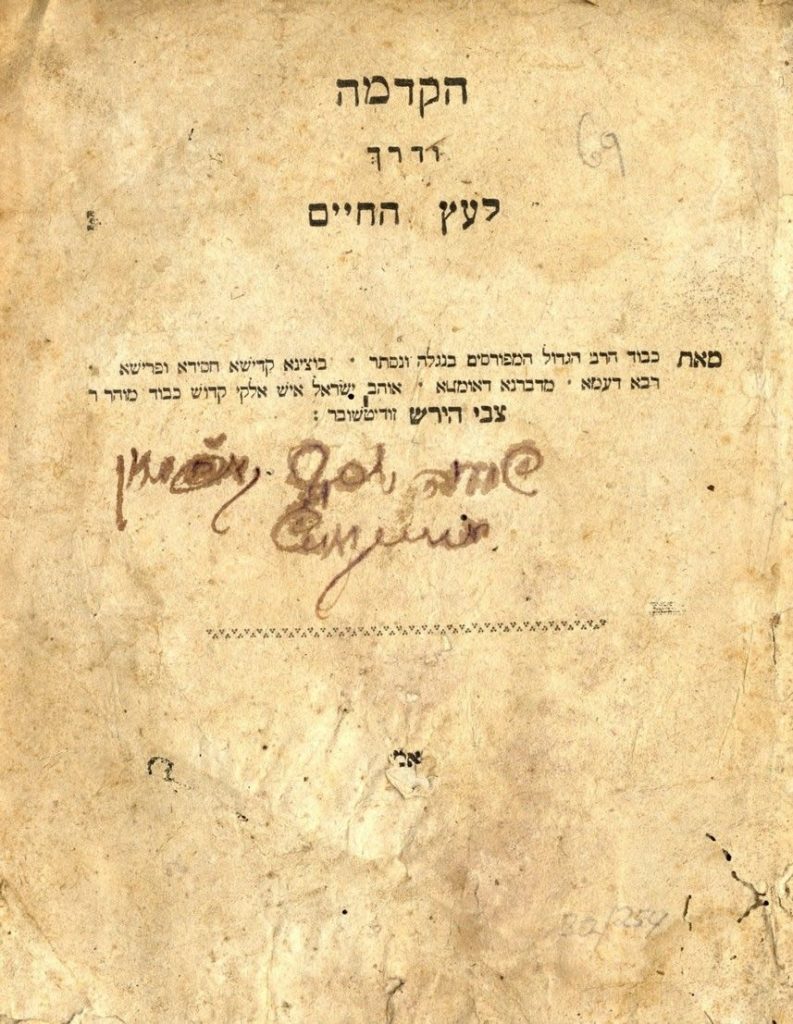
* Hakdama V’Derech L’Etz Chaim. Kabalistic work by Admor Zvi Hirsh of Zidichov, known as the “Sar Beit HaZohar”. He passed away in 1831. The work was first printed a year later, in 1832. This edition was then printed in [Lemberg? after 1832]. [1], 9, 11-12, 2-5, 5-7 leaves, 24 cm. Blemish to the title page and last leaf. Worming holes. Moderate-fine condition.
* Seder Nusach HaKafot HaNe’emarim B’beit Medrasho…R’ Elimelech of Lizhensk. [Klausenberg]. 1925. First edition, printed by his grandson Rabbi Shimon Schiff of Zelizensk. 30 leaves, 19 cm. Jacket title page. Fine condition.
* Toldot Aharon. Chassidut by Rabbi Aharon of Zhitomir. Lemberg, [1864]. Second edition. Copy from the library of Rabbi Aharon Marcus. 43, 48 leaves. 25.5 cm. Fine condition.
* Orach L’Tzaddik, Imrei Kodesh from Rabbi Eliezer Lipa, son of Rabbi Elimelech of Lizhensk. Warsaw, c. 1910. 126 pages, 22 cm. Fine condition.
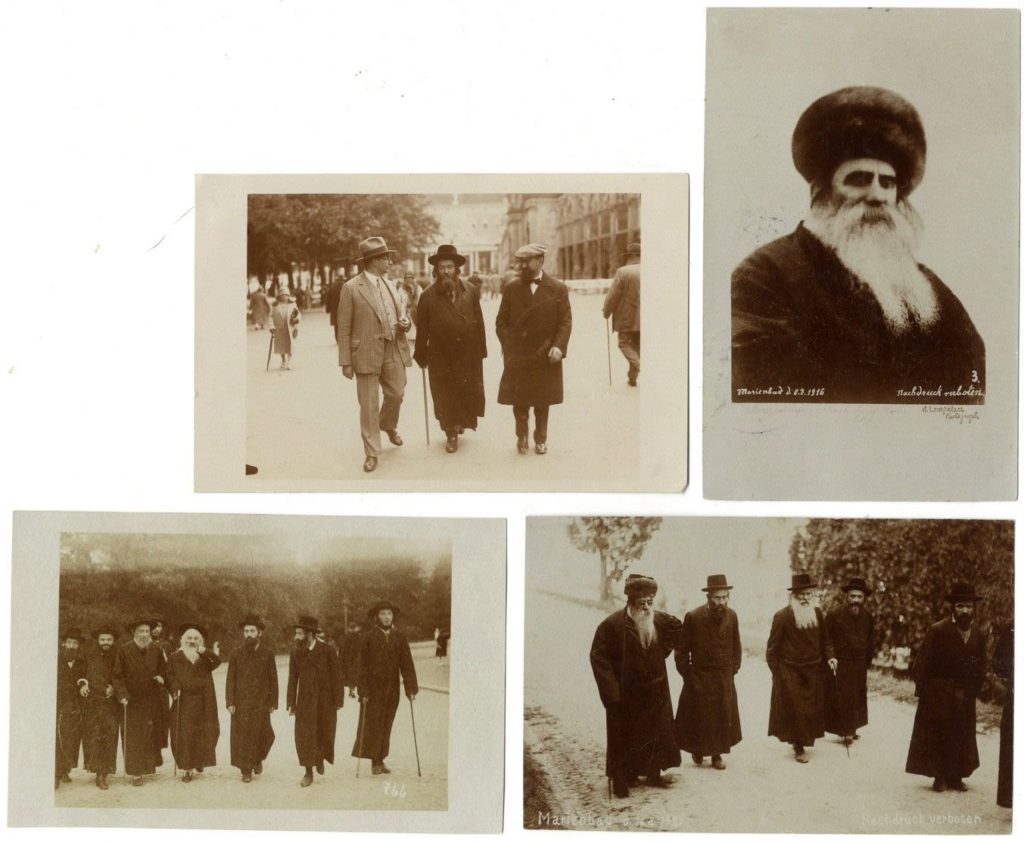
Four postcards of the Belzer Rebbe, the “Chekel Yitzchak” of Spinka and Rabbi Meir Shapira in the spa town, Marienbad (Mariánské Lázně), Czechoslovakia, 1920s.
*Rabbi Yissocher Dov Rokeach of Belz. * The Belzer Rebbe with rabbis and
gaba’im during his stay in the village.* Rabbi Yitzchak Eizik Weiss, the Rebbe of Spinka, with rabbis and
gaba’im during his stay in the village.* Rabbi Meir Shapira, Rosh Yeshiva of Chachmei Lublin, with communal activists during his stay in the village.
The postcards bear the stamp of photographer Hans Lampalzer. Very fine condition.
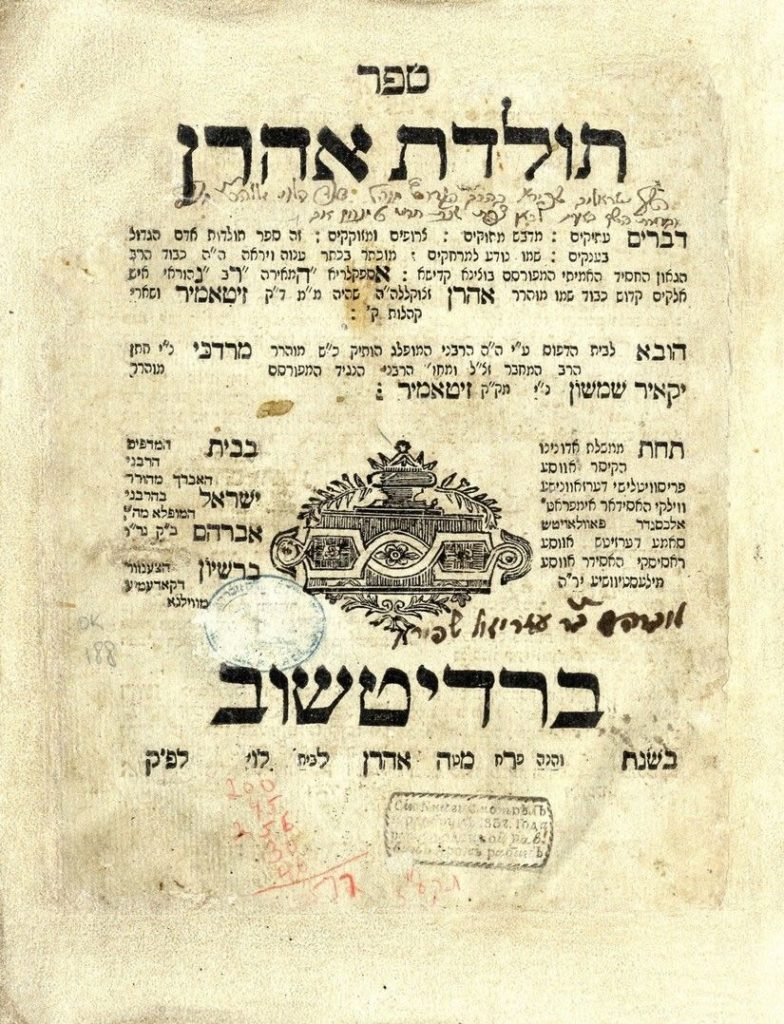
Toldot Aharon by Rabbi Aharon of Zhitomir, Berdichev 1817. Yisrael Bak Printing Press. First edition. With approbations of Rabbi Avraham Yehoshu Heschel of Apta, author of Ohev Yisrael ; Rabbi Mordechai of Chernobyl and the author’s friend Rabbi Yisrael, son of Rabbi Levi Yitzchak of Berdichev.
[2] 191 [should be: 192] leaves. 23 cm. Blueish paper, wide margins.
“Ancient things sweeter than honey purified and cleaned” on the order of the
parshiot, and at the end,
likutim. By Aharon of Zhitomir, the greatest student of Rabbi Levi Yitzchak of Berdichev. In this book Rabbi Aharon quotes many things which he heard from him. After the death of the author of
Ohr HaMeir , Rabbi Aharon was chosen in his place as Maggid of Zhitomir, at his aforementioned rabbi’s recommendation. He died in 1816. Stefansky
Chassidut 604.
New leather cover. The margins on a number of the first leaves have been professionally restored. A few aging stains Very fine condition.
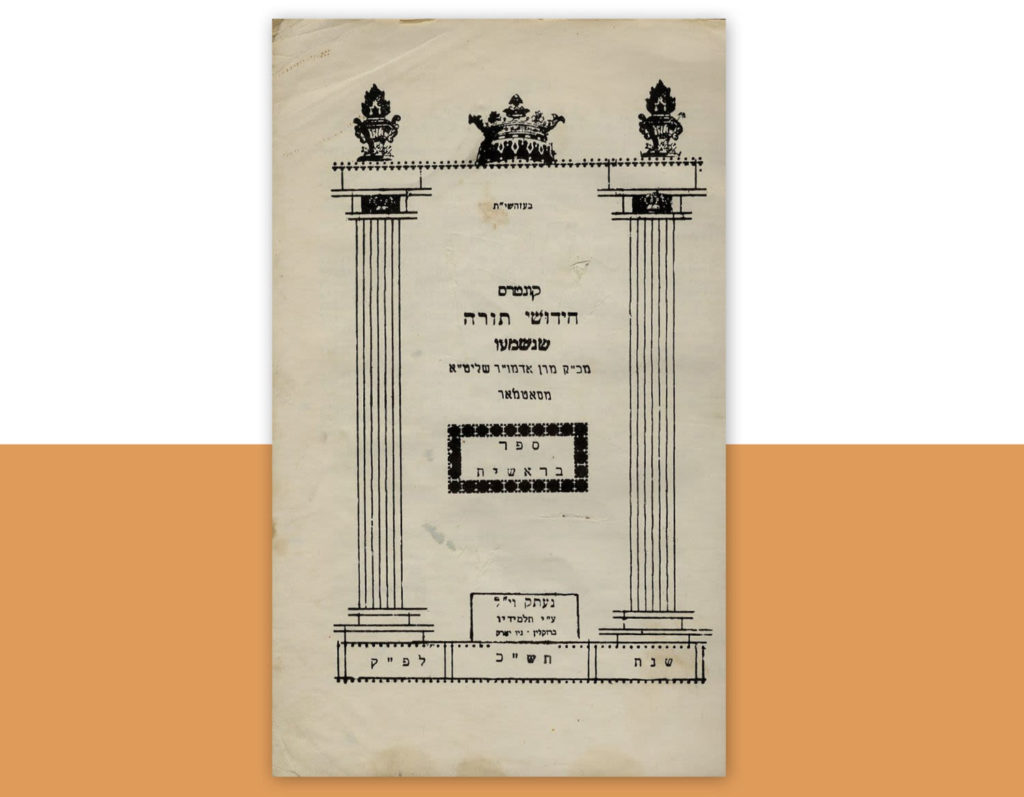
“Compilation of Torah novellae heard from the Admo”r [Rabbi Yoelish Teitelbaum], shlit”a [ztz”l] of Satmar. Sefer Bereishit. Transcribed and published by his disciples. New York, 1960.”
In the foreword, the two disciples, R’ Meir Yisrael Goldberg and R’ Naftali Leibowitz, write that the compilation was written in Hebrew; however, the Admo”r spoke in Yiddish.
114 pp, 23.5 cm. Stencil print.
Fine condition. Aging stains. Folds in the corners of the leaves. Partially detached jacket cover; lacking back binding.

Chumash Bamidbar with three interpretations … with the Ohr HaChaim commentary and the Be’er Mayim Chayim commentary, and the Yeshuot Ya’akov commentary by Rabbi Ya’akov Orenstein. Lettering as in Zhitomir. Lemberg, 1872. Rare. In the Bibliography , only Chumash Shemot is listed.
Before us is a rare Chassidic Chumash, with the commentaries Ohr HaChaim and Be’er Mayim Chayim, and the Yeshuot Ya’akov commentary by the renowned gaon, Rabbi Ya’akov Orenstein, rabbi of Lvov, that was printed at the end of the chumash. Shabbat prayers in nusach Sephard at the end of the Chumash.
Many pages are not numbered. 22 cm. Two title pages.
Fine condition. Aging stains. Single worming perforation. Several partially detached leaves. Minimal slight tears. Original leather binding, blemished.
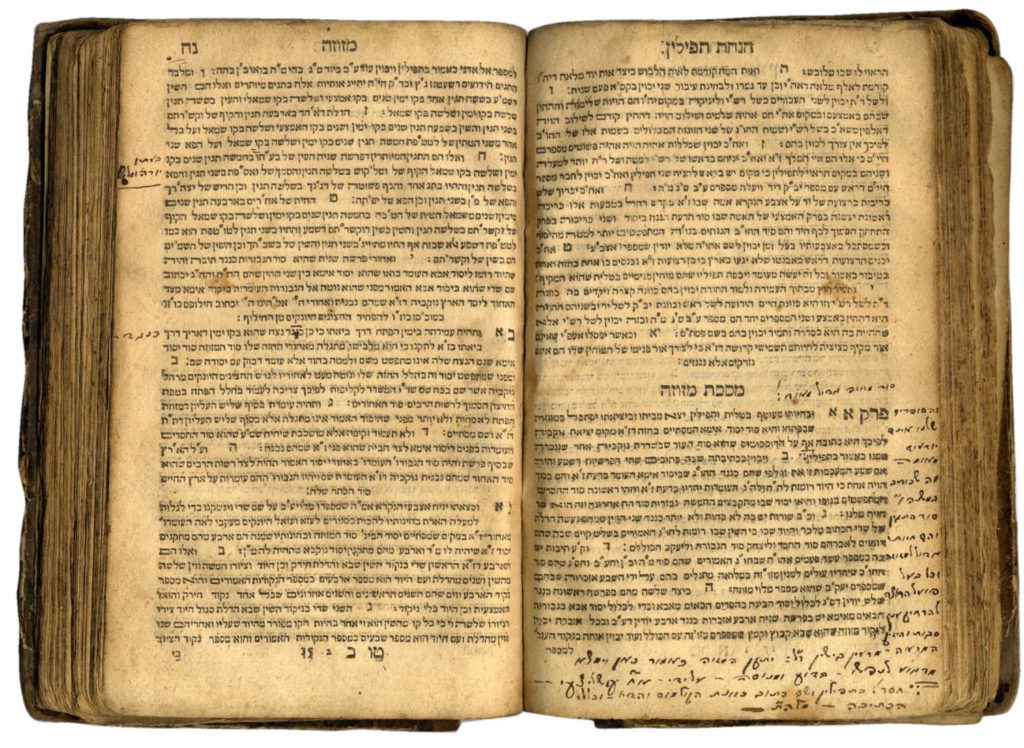
Mishnat Chassidim . Kabbalah, by Rabbi Emanuel Chai Ricchi, first edition, Amsterdam, [1727]
This book was sent by Rabbi Yisrael of Ruzhin – who was known as ‘King of Israel.’ He bore the distress of the Cantonist decree and concerned himself with encouraging the Cantonists and drawing them close so that they would not become disconnected from the Jewish nation. He sent it to one of the Cantonists whose name was Rephael son of Yaakov Kishlitzki, who during the many years he was in the Czar’s army studied and adhered to the book. It also served him as something of a diary. On the five empty leaves at the end of the book and the empty spaces at its beginning, he documented his spiritual life at length, starting with a detailed description of how the book was sent to him by Rabbi Yisrael of Ruzhin, and onward. (Leaf 4:1) “Not to be proud or to boast, just to remember – this holy book, which was in my hands as well when I was at work – working for the Czar, was sent to me as a gift by the by the Pure Great Rabbi Yisrael of Ruzhin , and I studied it as best I could … and the first time I finished it with Heaven’s help was on Purim, in Russia, in a village in Novo Bard, and I hadn’t even heard the megillah and hadn’t seen any Jewish people, yet G-d in his grace was with me, a Jewish man, a servant to G-d and king – Kishlitzki – Purim 5611 (1851).”
On leaf [2] 1, he signs his full name, “The words of a Jewish soldier, Rephael son of Yaakov.” It is interesting to note that the words were written approximately two months after Rabbi Yisrael of Ruzhin’s passing, yet the soldier did not add the word “ZTz”L nor words of sorrow. Apparently, the report had not yet reached him in the distant place he was stationed.
Reading the soldier’s diary reveals the wisdom and holiness of Rabbi Yisrael of Ruzhin, since the soldier was apparently kidnapped during his early teens, he knew how to read and write, but did not really understand the deep kabbalistic book that was sent to him. Yet he read it time and again, as mentioned above: “The first time I finished it …” and elsewhere: “And the second time I finished it was on the eve of Shabbat Kodesh Nachamu the 10th of Menachem Av 5614 (1854) here in Laver close to the royal city of Petersburg.” The book elevated him and prevented him from being distanced, with his feeling that he was studying “kabbalah.” At the end of the book there is a sheet of errata with the printing errors that appear in the book. It is heart-rending to see that the soldier, for whom this was apparently his only book, corrected each one of the errors that appear on the sheet of errata in the body of book. It is fascinating to read his descriptions of what he had gone through and how the holy book before us had protected him throughout his spiritual trials. For example, “Due to the extent of His personal supervision, it was not taken from those of low value, with cut-off sideburns, shaven beards, who eat repulsive soup.” Or later, “And He knows all our secrets, and that until now I have eaten the king’s bread from the non-kosher pot, since we are still under and with the soldiers of Russia, he brought me this book so that I will not forget what I learned … in my youth and when I was free.”
A harsh enlistment edict was decreed in Czarist Russia in the early 19th century which greatly affected the Jewish communities for approximately thirty years [1827-1856]. When the Czar Nicholas I rose to power [1825], he decided to introduce new arrangements in his country to reeducate the Jewish communities. Therefore, he ordered a forcible recruitment of young Jewish boys, to be given Christian military education so that when they return home after their military service, they will convince others to follow in their new ways. The reeducation was done in small huts – “cantons,” thus giving the edict its name, ‘The Cantonists.’
The Jews did their best to prevent execution of the edict, including exerting pressure and paying large amounts in bribes. These attempts failed and the army began recruiting 12-year-old boys for a prolonged service period of 31 years!
Every community was obligated to send a quota of recruits. When this quota was not met, leaders of the community hired people to kidnap children to be sent to the army. Rabbinical leaders protested against the edict and tried to have it cancelled; indeed they succeeded in releasing some of the children. Yet the majority were recruited and served for dozens of years in the Russian army. There were Jewish communities of many Cantonist soldiers, such as in Kharkov, who succeeded in retaining their Judaism at any price, despite the many great trials they underwent, as described in Shmuel Rothstein’s book Cantonistim (Cantonists). Many of them, however, did not know how to read or write and were unfamiliar with many of the mitzvahs, since they had not been living among Jews for many years. Under supervision of the generation’s rabbis, emissaries were sent to teach them Torah and help them observe the practical mitzvahs.
Rabbi Yisrael Friedman, the holy Admor of Ruzhin, was also in touch with the Cantonist soldiers. Rabbi Mottel of Slonim recalled in his writings that 72 Jewish soldiers serving in the Russian army sent a note to Rabbi Yisrael during the Crimean War in which they wrote: “Avi Avi Rechev Yisrael U’Farashav shelter the remnants of Israel so that pure blood will not mix with impure blood.” Rabbi Yisrael sent them his holy blessing and added a “protection” for each of them. He also ordered each one of them them to wear his small tefillin throughout the war. These soldiers were cavalry riders and were sent to the front. They experienced open miracles and were all saved, every last one of them. At the end of the war they all came to the Admo”r.
Eventually, on the 25th of Av 1855, Czar Alexander II cancelled the recruitment edict.
The holy book Mishnat Chassidim was sacred in the eyes of leading Chassidic Admors and is mentioned many times in Chassidic works. Rabbi Yisrael of Ruzhin’s grandfather – the Maggid of Mezeritch – mentions it [“כתוב במשנת חסידים בפקודת נוקבא”], as well as Rabbi Shnuer Zalman of Liadi, and others.
[6], 132, [2] leaves and [4] additional diary leaves. 16 cm. Dedication inscriptions, stamps and signatures. Moderate-fine condition. Aging stains. Repairs with tape. Original binding, partly detached and slight wear.
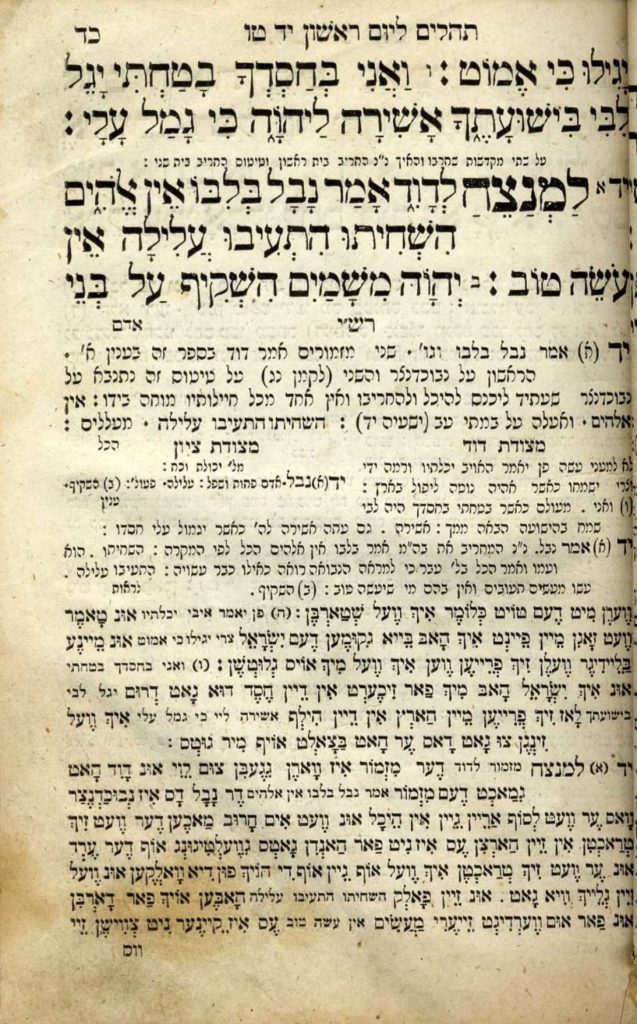
Psalms with the commentaries of Rash”i and the Metzudot and a Yiddish translation. Special edition published by Rabbi Yitzchak of Nezkizh, a disciple of Rabbi Levi Yitzchak of Berditchev and the Seer of Lublin, and author of the book Toldot Yitzchak . Copy with lack.
Approximately 6000 copies were printed of this edition. His goal was to sell the books at half the cost of their printing in order to bring merit to the many and in honor of King David. However, after the printing, a fire started which burned the study hall of the Chassidism and the Chassidim asked him to sell the books for a high price in order to cover the expenses caused by the fire. According to tradition, the rabbi used to kiss every copy he sold and bless it ( Zikaron Tov , section II, 84, question 4).
Despite the lack and blemishes of the first 23 leaves, the rest of the book’s leaves are in very fine condition. 19 cm.
1-6 lacking. 7-23 torn leaves with damage to text – mainly in the commentaries. Isolated words in the Psalms are blemished. 24-203, 1-29 leaves. With Shaar HaMaamadot.
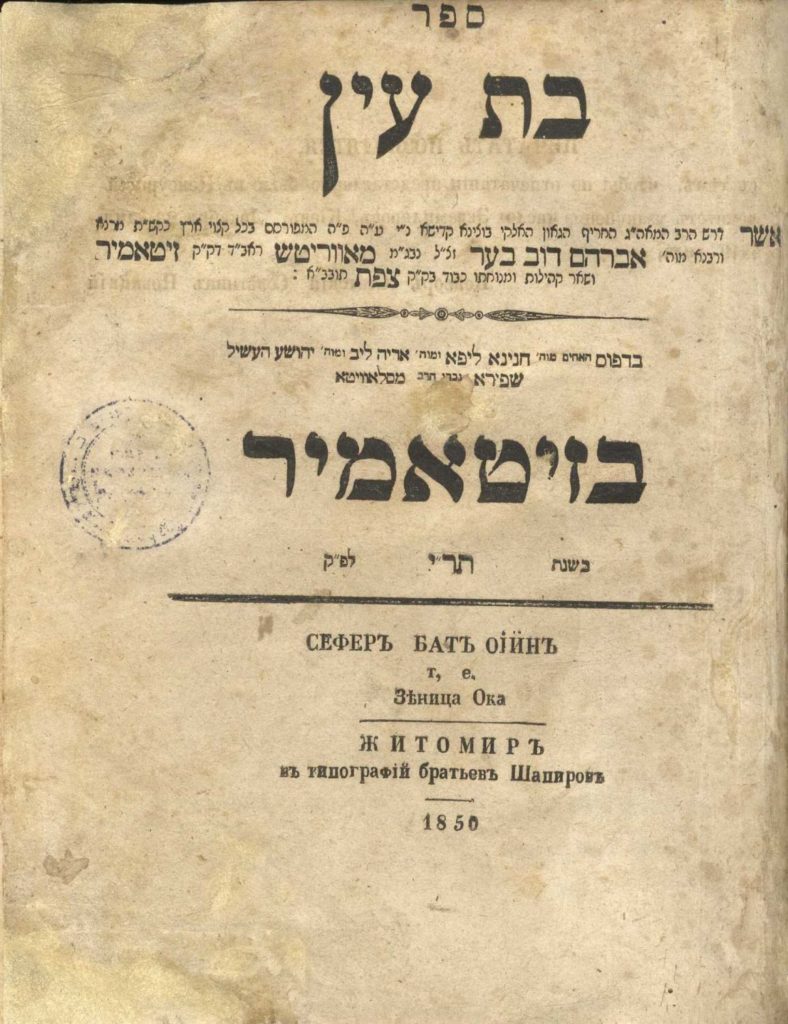
Sefer Bat Ayin on the Torah, sermons delivered every Sabbath by the Admor Rabbi Avraham Dov [Auerbach] of Ovrutch. The articles were written by two of his disciples, one was Rabbi Meshulam Zussman of Zhitomir – from whose manuscript this edition was printed. He was the primary writer of the Admor’s Torah, as he testifies in the foreword to this edition, “And the holy Admor z”l told me to write his holy words … and I showed him what I wrote and what needed some proofreading, he proofread himself … and he would look into them throughout the entire day whenever he had time, from beginning to end, many times over. The second writer was Rabbi Yisrael of Paltishan who ascended to the Land of Israel with the Admor. Both disciples printed the Admor’s articles, each from the manuscript he had in his possession. The actual text clearly differs, because they were written after Shabbat from memory, each in his own style. The edition before us has several known virtues. The first, as mentioned, was that the writer Rabbi Meshulam Sussman was designated by the author of Bat Ayin , and for good reason, as he was gifted with the pen of a ready writer and possessed a clear and easy style so that the ideas which were introduced at length in the Jerusalem edition and are hard to understand were brought in this edition in a precise style. An additional virtue is that before this edition was printed, the author of Bat Ayin himself sent him the second manuscript, that of Rabbi Yisrael, and he compared the two manuscripts. As he writes in the introduction, “and after some time, he sent me back the holy writings with a supplement written by Rabbi Yisrael of Paltishan.” Rabbi Meshulam Sussman corresponded with the author of Bat Ayin about its printing, when he already resided in the Land of Israel, not knowing that his friend Rabbi Yisrael was also involved in printing the book, which is why he didn’t mention it in his foreword to this edition, despite the fact that Rabbi Yisrael completed printing the book in Jerusalem approximately three years before the printing of this edition. This edition is undoubtedly the complete one – the final one, as mentioned. The Admor Rabbi Aharon of Chernobyl writes in his approbation to the book [the Zhitomir 1869 edition], “Any man who buys this holy book for its full price will merit seeing the fruit of his labor and G-d will shine His light upon him …” and in the approbation by the holy Rabbi Yaakov Yisrael of Cherkes, “and the merit of the holy rabbi, the author of this book, will stand by him and his children in all his endeavors, spiritual and material …”
This later version of the first edition was published by the nephew of Rabbi David Yosef of Chmielnik, and was printed by the brothers Rabbi Chanina Lipa, Rabbi Aryeh Leib and Rabbi Yehoshua Heschel Shapira, grandsons of the rabbi of Slavuta, Zhitomir, 1850.
Rabbi Avraham Dov of Ovrutch [1760-1840], was known as the ‘Bat Ayin’ after the name of his book. He was one of the greatest Chassidic lights, a disciple of Rabbi Menachem Nachum of Chernobyl, Rabbi Zussia of Annipoli and Rabbi Levi Yitzchak of Berditchev. He served as a rabbi in Zhitomir and Ovrutch, and in his later years, in Safed. It is well-known that on the 24th of Tevet 1837, there was an earthquake in Safed and its surroundings and there were many casualties. The ‘Bat Ayin’ was then praying Minchah in his study hall . When the tremors began, the rabbi ordered all the worshippers to gather around him and lie on the ground. A large part of the study hall collapsed, but the part where they were gathered remained intact and the roof, too, remained suspended in the air. The worshipers were miraculously saved. Written on a sign that can be seen to this day in the study hall: “How awe-inspiring is this place, the study hall of Rabbi Avraham Dov, the Admor of Ovrutch, who foresaw the earthquake in Safed in 1837. Due to his great merit, half the study hall was saved from destruction and the Admor and his disciples survived.” It can be seen to this day that the study hall is comprised of two sections: the old one which survived the earthquake, and the new one, which was destroyed and rebuilt. In 1841, a plague broke out in Safed which took many lives. The Rebbe of Ovrutch was among the victims of the plague, and according to legend, he promised that he would be its final victim. On the 12th of Kislev, he passed away, and the plague indeed ended. He is buried in the ancient cemetery of Safed, in the cave in which the author of Arvei Nachal and Rabbi Aryeh Leib of Woltshisk are buried. In recent years, the place has become a pilgrimage site, to a large extent because Rabbi Elimelech Biderman conducts a Hillulah on his grave on the day of his yahrzeit with thousands of participants from Israel and abroad.
[4], 244 pages (the last 5 leaves – which are not part of the body of the book but a halachic responsum that was added to it – are lacking). 20 cm. Stefansky, Chassidut , no. 104.
Fine condition. Aging stains. Artistic restoration to the margins of the first leaves. New, impressive leather binding with gilt impressions.
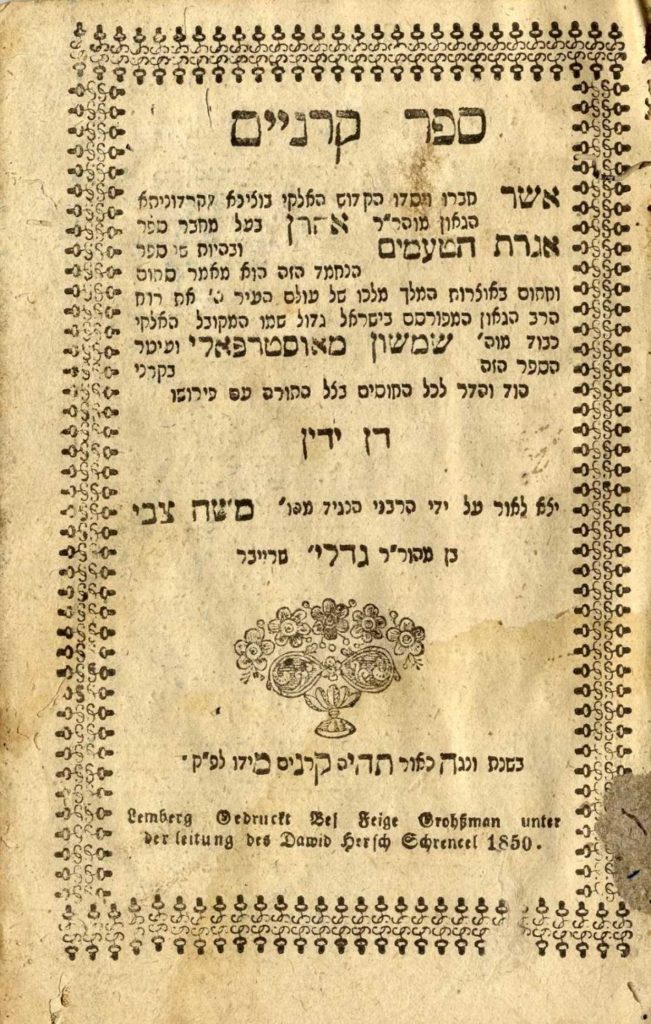
Araba’ah Charashim . Sermons on the four Torah portions, the Passover haggadah and more, by Rabbi Aryeh Leib of Lantzut, as well as holy customs from our honored rabbi … Elimelech ztzuk”l of Lizhensk, known as “Tzettil Kattan.” [Lvov 1849]. First edition, and first edition of the “Tzettil Kattan” by the author of Noam Elimelech .
The author was the disciple of the Maggid of Kozhitz and of the Chozeh of Lublin. Rabbi Naftali of Ropshitz and Rabbi Tzvi Hirsch of Zidichov praised him extensively. He was known as extraordinarily sharp and of tremendous genius. He served as rabbi of Lantzut, then of Kishinev in place of Rabbi Chaim of Chernowitz, by recommendation of the author of Ohev Yisrael . He left many writings, with this being the first printed. Also refer to Alfasi, Encyclopedia L’Chassidut A 328-329.
Leaf 3 lists proper conduct by Rabbi Elimelech of Lizhensk. Including 17 sections, with כ”ז מצאתי בכ”י [“all this I found in manucript”] printed at the end. Before us is the first printing of Rabbi Elimelech of Lizhensk’s “Tzettil Kattan.” Refer to Alfasi, Encyclopedia L’Chassidut A 236.
[4] 20 leaves, 18 cm. Stefansky Chassidut 64.
Bound with: Sefer Karnaim with the Dan Yadin commentary by Rabbi Shimshon of Ostropol. Lemberg, 1850. There is a handwritten gloss on leaf 2, leaf 3 contains a faded gloss. Bound with Likkutei Shoshanim by the rabbi and G-dly kabbalist Rabbi Shimshon, the Maggid of Ostropol.
Owners’ signatures and notations on the flyleaf. Several glosses in Sefer Karnaim.
Moderate condition. Worming holes. Sefer Karnaim has severe worming holes with damage to text, “Tzettil Kattan” has minimal worming holes.
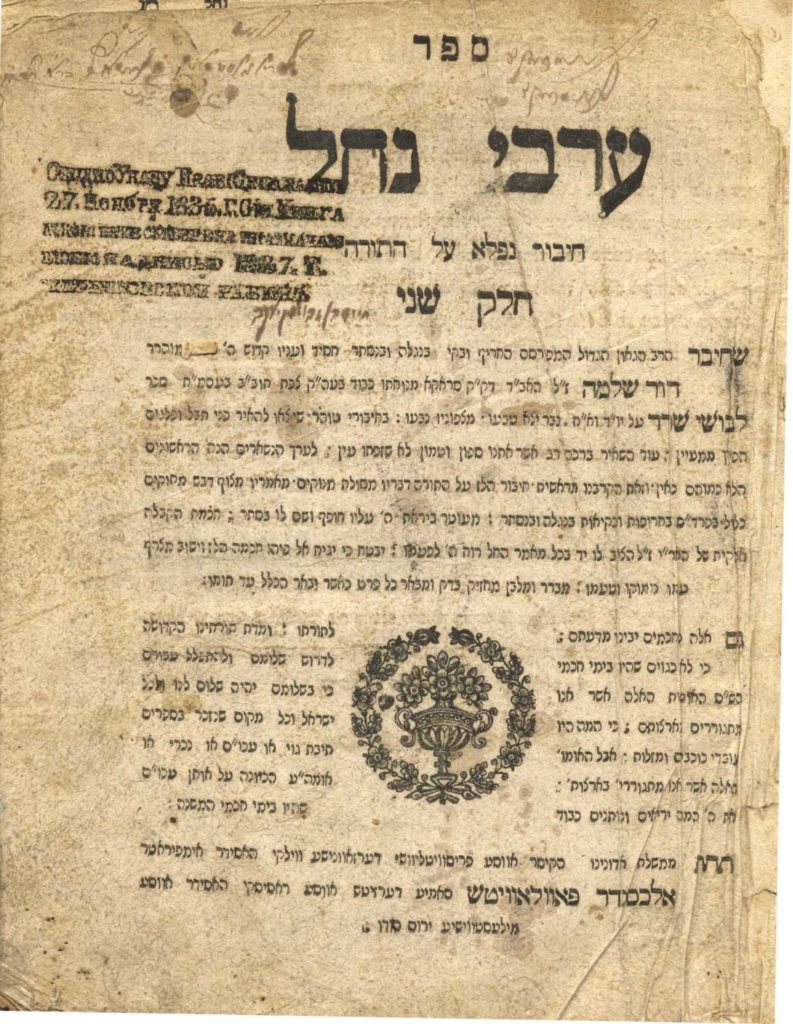
Arvei HaNachal al HaTorah , second part. Chassidic work on the Torah, by Rabbi David Shlomo [Eibeshutz.] [Sudilkov 1825-1826.] First edition.
First edition of the book Arvei Nachal , one of the fundamental books of Chassidut. The author, Rabbi David Shlomo Eibeshutz [1755-1817], was a Chassidic leader who was also an expert adjudicator, he was also known for his book Arvei Nachal al HaTorah .
The first edition, before us, was printed without indication of place nor year of printing, it is generally accepted that it was printed in Sudilkov in 1835. The second edition was also printed in 1835. Apparently, the first edition was printed in two variants with tiny differences between them. This copy is identical to the copy in the National Library, serial number 001174782 – it also appears as a digital edition in the National Library’s website.
[1], 43-168 leaves, 23.5 cm. Stefansky Chassidut 470. Moderate-fine condition. Tear in page 47 without lack to text. Detached binding, lacking spine. Stains.